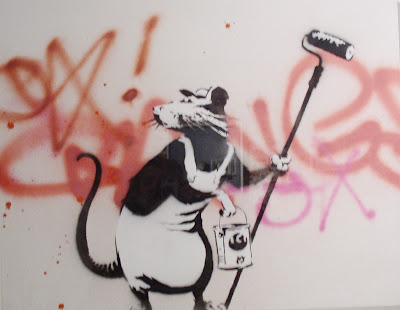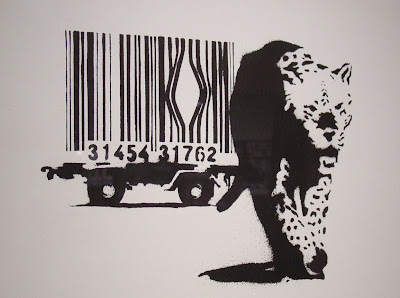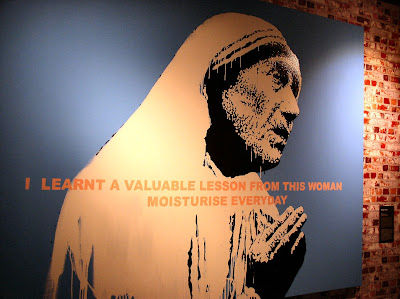Banksy is a British graffiti artist whose works of political and social commentary have appeared on streets, walls, and bridges of cities throughout the world. His message is usually anti-war, anti-capitalism, anti-consumerism or anti-establishment. He remains anonymous because graffiti is a criminal matter, and there are those who see him as nothing more than an over-hyped vandal. Nevertheless, Banksy has managed to become one of the world's most recognized artists while remaining relatively anonymous. His style has elevated him beyond a man with a spray can to a highly creative artist in his own right. He is responsible for “guerilla work” becoming mainstream as a viable form of art.
Foyer of the Beurs van Berlage building
The Beurs van Berlage is a building on the Damrak, in the center of Amsterdam. It was constructed between 1896 and 1903 and is now used as a venue for concerts, exhibitions and conferences. Iconic works by Banksy were featured in the Beurs van Berlage from June 18 to September 30, 2016.
“Balloon Girl” (London 2007) and “Love Rat” (2004) at entry to exhibit
“Balloon Girl” was a mural on the side of a printing shop in East London. A red heart-shaped balloon has just slipped beyond the little girl’s grasp, and the words “there is always hope” are written on the wall behind the girl. It’s not clear if the piece represents a loss of hope or the possibility of eventually getting what you hope for.
“Balloon Girl”
In March, 2014, Justin Bieber tattooed the balloon girl design on his arm and captioned it, “Don’t let your dreams float away.” In February, 2014, some twelve years later, it was announced that the owner of the wall planned to remove the work and sell it at auction for an estimated price of $850,000.
In October, 2018, the painting, “Balloon Girl” partially shredded itself moments after it sold at Sotheby’s auction house in London for $1.4 million. A secret shredding mechanism had been inserted into the frame prior to the sale, and a remote-control button was pressed by someone inside the venue to activate the cutting mechanism. Banksy said, “In rehearsals it worked every time.” At Sotheby’s, however, the spray-paint and acrylic on canvas only went halfway through the shredder. The winning bidder opted to continue with the purchase of the piece.“When the hammer came down last week and the work was shredded, I was at first shocked, but gradually I began to realize that I would end up with my own piece of art history,” the unnamed purchaser said. Sotheby released a statement that said "Banksy didn't destroy an artwork in the auction, he created one," and called it "the first artwork in history to have been created live during an auction."
Banksy fun car
Banksy Collage composed of previously completed artwork
Sandwich Board-wearing Monkey (2002) is the artist’s take on Darwin’s Theory of Evolution. The piece depicts a monkey in a human-like, upright position with a sandwich board hanging on its shoulders, which says, "Laugh now, but one day we'll be in charge." His expression shows he feels downtrodden and ashamed. The words on the sign are words of prophecy; they predict that the ashamed and the downtrodden will rise above the rest of society. As in the “Planet of the Apes” films, our primate ancestors will fight for their rights and respect in a human-dominated world.
Turf War
Banksy's first major exhibition in 2003, "Turf War," was one of England's best, if not the briefest, of shows. Staged in a warehouse, the exact location was kept secret until the last minute. "Turf War" was supposed to be open from July 18 to 24, but police closed it down two days after the opening because artist Banksy was a wanted man. "I have warrants out for my arrest and besides I don't like dealing with the public," he said. Graffiti may be a hot cultural form, but in London, it's punishable with a prison sentence of up to ten years.
“Our culture is obsessed with brands and branding" says Banksy. "Turf War" featured live cows, sheep, lambs and a ewe literally branded with Banksy's trademark spray-painted stencils. Pigs were painted as police officers, sheep were painted as concentration camp prisoners, and cows were covered in stencils of Andy Warhol's face. Above this menagerie was an enormous stencil painting of Winston Churchill sporting a green Mohawk with the word "Thug" branded underneath. The man who was Prime Minister of Britain during World War II and again in the first half of the 1950s, was reimagined by Banksy as a punk rocker. Banksy adorned Churchill’s head with a bright green strip of hair, which resembles a piece of turf. Boiling war down to its very basics, war is two gangs fighting over a piece of turf, and it brings devastating consequences in its wake.
While the paint on the animals was said to be animal-friendly, and the show was approved by an inspector from the RSPCA, protesters still picketed against cruelty to animals. One woman even chained herself to the fence of a painted cow. Animal activists protested the exhibit, but the irony is that it raised awareness of the exploitation of animals. The animals themselves may have been the reason the show was shut down. Reportedly, when they became hot and distressed and were taken back to their farm, organizers did not want to go on without the main animal attractions. (Unfortunately, I will never know how Banksy got these animals to stand still and tolerate being spray-painted.)
“Elephant in the Room”
A Banksy exhibition in Los Angeles in September, 2006, featured a live "elephant in a room," painted in a pink and gold floral wallpaper pattern, which was intended to draw attention to the issue of world poverty. (Nobody talks about poverty, but there it is, bigger than life, in the middle of a room.) Although the Animal Services Department had issued a permit for the elephant, after complaints from animal rights activists, the elephant appeared unpainted on the final day. Its owners rejected claims of mistreatment and said that the elephant had done "many, many movies. She's used to makeup."
Bronze Rat with paint brush
Banksy explained his fascination with rats: “They exist without permission. They are hated, hunted, and persecuted. They live in quiet desperation amongst the filth. And yet they are capable of bringing entire civilizations to their knees. If you are dirty, insignificant and unloved, then rats are the ultimate role model.” They are emblematic of street art itself. On a lighter note, Banksy confessed, “I’d been painting rats for three years before someone said, ‘That’s clever, it’s an anagram of art,’ and I had to pretend I’d known that all along.”
“Love Rat” implies that street art is worthy of love, too, and that these small contributions can make an impact on the surrounding community.
“Radar Rat”
This shrewd rat has a tape recorder in one hand and a sonic radar in the other. He wears headphones and appears to be listening intently to the world around him. This rat is representative of the true nature of rats: intelligent, tenacious and with a matchless survival instinct.
“Umbrella Rat”
Jet Aircraft Carrier - Applause
The source image was a military bomber on an aircraft carrier during the term of George W. Bush. A figure in the foreground holds up a cue card with the word, “Applause” on it. It may be considered a comment on the glamorization of modern warfare.
The source image was a military bomber on an aircraft carrier during the term of George W. Bush. A figure in the foreground holds up a cue card with the word, “Applause” on it. It may be considered a comment on the glamorization of modern warfare.
“Stop and Search”
“Stop and Search” parodies the Wizard Of Oz. The piece shows Dorothy, a truth-seeker who travels in search of a better place, being stopped by an officer in riot gear who is suspicious about possible contraband she's really carrying in that basket of hers. Dorothy represents innocence and freedom, but even she is not free from the irrational limits that state security can reach.
“Stop me before I paint again”
“Bomb Hugger” (2003)
“Flag” references the iconic Iwo Jima flag-raising image of US Soldiers after capturing the island of Iwo Jima on Mount Suribachi on February 9, 1945. In Banksy’s version, disenchanted urban young people are standing victoriously over a dilapidated automobile. The image implies a takeover by children in an oppressive world without adults.
"Flag"
“Media” (2006)
A sad little girl bleeding from the nose and holding a teddy bear is standing in rubble. Two men are photographing her, and a woman with a clip board is preventing two Red Cross workers from helping her. The members of the news media are not helping the child but are taking advantage of the situation and documenting it for their own benefit. The scene illustrates the lengths the news media will go to dramatize a story that will grab the attention of their audience.
Girl in a gas mask/Ballerina with Action Man Parts in bronze
She resembles a Dégas ballerina, but she has on a gas mask like one worn by the Action Man toy.
“Love is in the Air”/ “Flower Thrower” (Jerusalem 2003)
This work features a man dressed in traditional riot gear, with a bandana hiding his face, and his cap on backward. His stance is one of a person about to lob a Molotov cocktail; he's taking aim and is ready to throw his weapon. However, instead of a weapon, he holds a bunch of flowers (which are the only part of the mural to appear in color.) This piece is located on a wall on the side of a garage in Jerusalem on the main road to Beit Sahour, Bethlehem. Banksy is advocating peace instead of war, and he opted to install this message of peace in a high-conflict area. It is an example of Banksy's use of art to relay messages of social importance.
“Bulletproof David”/ “Suicide Man” Terrorism plays a major role in Banksy’s artwork. There are 2 versions of the “David” sculpture. In one version, David has on a bulletproof vest and in the other, David is a suicide bomber.
David as “Suicide Man”
“Sale Ends Today”
“Bar Code Leopard” (2002)
“Christ with Shopping Bags” is a satire on values, perception and the transformation of the Christmas holiday. In the past, Christmas was about the birth of Jesus Christ and not a time to be preoccupied with the material things in life. In modern times, Christmas has become symbolic of uncontrolled consumerism, when ostentatious gifts are highly valued.
“Morons” is Banksy’s harsh critique of the art market. The image depicts art collectors gathered around an auctioneer. The painting up for sale is Banksy’s. In his own words, “The art world is the biggest joke going. It’s a rest home for the over privileged, the pretentious and the weak.” The irony that his anti-establishment art commands huge prices isn’t lost on him. “I love the way capitalism finds a place—even for its enemies.” Banksy’s work mocks a world that measures the worth of a piece of art only according to where the author ranks in the international artist-ranking at the present time.
“Di Faced Tenner” (£10 notes)
In August 2004, Banksy printed one million pounds worth of his “Di Faced Tenner.” The play on the term "defaced" (di-faced) comes from the fact that Banksy substituted the Queen's face with that of Princess Diana and changed the text "Bank of England" to "Banksy of England." The value of the individual notes has gone hundreds of times over their face value.
“I want to meet my true love for cheap casual sex”
The ugly truth about society’s sex obsession is that it never leads to fulfillment.
Mother Teresa
Mother Teresa is an example of Banksy’s desecration of a beloved figure who has become a pop-culture icon of virtue. Regarding religion in general, Banksy criticizes the place of Christianity and religion in contemporary Western society.
UFO Invasion
Banksy goes beyond the limitation of a frame to show a UFO zapping a Banksy painting. It is a traditional harbor landscape with UFOs shooting lasers into it. Such oil on canvas paintings are among the rarest and most sought-after of Banksy’s works.

































No comments:
Post a Comment